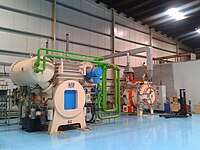
Photo from wikipedia
To further improve the mechanical properties of H13 steel at room and high temperatures, its precipitates were regulated based on the Thermo-Calc results. Scanning electron microscope (SEM), electron backscattering diffraction… Click to show full abstract
To further improve the mechanical properties of H13 steel at room and high temperatures, its precipitates were regulated based on the Thermo-Calc results. Scanning electron microscope (SEM), electron backscattering diffraction (EBSD), transmission electron microscope (TEM), and X-ray diffraction (XRD) Rietveld refinement were used to study the effect of the intercritical annealing on the microstructure and mechanical properties of H13 steel. The results show that the intercritical annealing at 850~95 °C increased the VC volume fraction from 2.23 to 3.03~3.48%. Increasing the VC volume fraction could inhibit the M7C3 precipitation from 10.01 to 6.63~5.72% during tempering. A large amount of VC also promoted the M23C6 precipitation during tempering at higher dislocation densities. The intercortical annealing simultaneously increased the elongation of H13 steel. An excellent combination (room temperature: ultimate tensile strength (UTS) of 898 MPa and total elongation (TEL) of 19.35%, 650 °C: UTS of 439 MPa, and TEL of 27.80%) could be obtained when intercritical annealing is performed at 900 °C. Meanwhile, after aging at 650 °C for 128 h, the room temperature UTS and TEL decreased by only 31 MPa and 0.52%, respectively.
Journal Title: Materials
Year Published: 2022
Link to full text (if available)
Share on Social Media: Sign Up to like & get
recommendations!